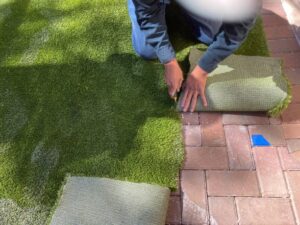Quality artificial turf lawns depend on various elements. One key factor is the infill material used beneath it – silica sand is best but other materials can also be used.
Look for quality artificial grass Adelaide with high thatch layers for realistic appearances, draining pet urine, rainfall and other moisture sources while protecting from mould growth and odour. This should prevent unpleasant odours as well as mould development in your artificial lawn.
1. Durability
 Quality artificial grass lasts for years and is UV-resistant to preserve its pristine look over time. Many synthetic lawns even come with a 10-year warranty, giving buyers peace of mind knowing they’ve made an intelligent investment.
Quality artificial grass lasts for years and is UV-resistant to preserve its pristine look over time. Many synthetic lawns even come with a 10-year warranty, giving buyers peace of mind knowing they’ve made an intelligent investment.
The yarn used to construct artificial turfs also significantly affects its longevity. Although nylon is often selected, polyethylene and polypropylene tend to be more resilient options that can withstand higher temperatures as well as wear and tear more efficiently than nylon can.
An important consideration in selecting an artificial lawn material is foot traffic frequency and volume. If children and dogs frequently visit, you need something durable enough to withstand daily abuse from both.
Your fake grass should also have two layers of backing to keep the yarn taut and stable; one-layer turfs won’t stand the test of time as effectively.
Colour and brightness can help to assess the durability of artificial turf, too. A high-quality artificial lawn features vibrant green hues that resist sun fading; additionally, its resistance to wear means it can withstand snowfall and rainfall – perfect for cafe gardens and outdoor restaurants!
2. Aesthetics
Artificial grass has become an increasingly popular option for those seeking to reduce time and cost associated with lawn maintenance. By selecting high- quality artificial grass Adelaide and taking proper care, your fake lawn will look pristine for years without the need to mow, reseed, or water it – however, it’s essential that more than aesthetic considerations be considered in selecting your synthetic lawn – to find one that lasts and performs optimally, the appropriate questions must be asked of them!
First and foremost, select products which have been thoroughly evaluated for harmful substances. You can do this by directly asking retailers or looking up manufacturer websites for certification details.
Second, consider the fibre type. Nylon (polyamide) is generally considered to be the ideal material for synthetic grass as it can be up to 33% stronger than polyethylene and 26% stronger than polypropylene; additionally, it’s softer and more durable so will hold up well under heavy foot traffic and pets better than its competitors.
Another factor to consider when purchasing artificial grass is pile density – low pile synthetic grass can appear sparse and thin; to achieve more natural looks it is recommended to opt for products with higher pile densities.
3. Environmentally friendly
Quality synthetic lawns don’t succumb to environmental influences like natural grass does – an excessively hot sun can dry out natural turf while too much rainfall can flood it – as these synthetic materials don’t react in such ways.
Artificial turf helps reduce an individual’s carbon footprint in several ways: It doesn’t require electric or fossil fuel mowers for mowing; watering can put strain on local resources when droughts strike, and using chemicals-laden fertilizers and herbicides are unnecessary to create beautiful outdoor spaces that reduce our impact on the planet and groundwater sources. All these factors come together in artificial turf’s positive impacts that help lower its environmental footprint.
Some landscapers make quality artificial grass Adelaide more earth-friendly by choosing earth-friendly infills like Safeshell, made from recycled U.S. walnut shells and the first USDA BioPreferred certified infill material. Not only is Safeshell chemical and allergen free but its cooling surface allows it to remain cool to touch while ultimately being fully biodegradable when its lifecycle ends.
Alongside their eco-friendly properties, certain varieties of synthetic grass also benefit the environment by being pet-friendly – protecting against wear-and-tear from urine damage – as well as being suitable for homes without easy access to lawn equipment. Certain brands, like IST’s antimicrobial synthetic grass product can even fight bacteria which cause unpleasant odours – especially important in kids’ and pets’ play areas and keeping your grass looking new for longer!
4. Low maintenance
Artificial grass has become increasingly popular as an option for residential lawns due to its reduced maintenance requirements and water consumption benefits. Artificial grass also doesn’t experience drought conditions that cause natural lawns to look brown – offering homeowners another viable solution for landscaping their lawn.
With quality synthetic turf, your yard will never again appear neglected or overgrown. You will save yourself hours mowing and performing other lawn chores, without needing to use fertilizers or pesticides that might put harmful chemicals near children or pets. Plus, saving water costs while decreasing chemical usage in your neighbourhood and community!
However, it’s essential to keep in mind that just like anything in your yard, quality artificial grass Adelaide requires regular care and upkeep to look its best. Regular rinsing with water, keeping free of debris, brushing high traffic areas with plastic bristle brushes as well as spot cleaning spills with water from hose or power washer are effective measures for maintaining its appearance while tough stains may require mineral spirits as a solution.